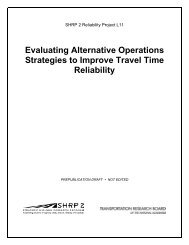Mileage-Based User Fee Winners and Losers - RAND Corporation
Mileage-Based User Fee Winners and Losers - RAND Corporation
Mileage-Based User Fee Winners and Losers - RAND Corporation
Create successful ePaper yourself
Turn your PDF publications into a flip-book with our unique Google optimized e-Paper software.
4. METHODOLOGY<br />
OVERVIEW<br />
This dissertation analyzes the distributional implications, <strong>and</strong> other equity considerations, of<br />
adopting alternative MBUF policies. The first phase of the analysis estimates changes in household<br />
VMT, fuel consumption, tax, <strong>and</strong> welfare for several federal <strong>and</strong> state MBUF policy options. The<br />
distributional implications of these are compared to current fuel tax policy <strong>and</strong> to each other. The<br />
various options, discussed in detail in the following section of this chapter, were selected to examine<br />
how the distributional implications of MBUFs may vary with the rate level <strong>and</strong> rate structure.<br />
The second phase of the analysis projects the distributional implications of several policy<br />
options over years 2015 to 2030 under various scenarios. This part of the study examines how the<br />
distributional implications might change under alternative future macroeconomic conditions <strong>and</strong><br />
future improvements in vehicle fuel economy. These scenarios are based on EIA assumptions <strong>and</strong><br />
projections.<br />
DISTRIBUTIONAL ANALYSIS OF ALTERNATIVES<br />
This section describes the methodological approach for estimating <strong>and</strong> then comparing the<br />
distributional implications, <strong>and</strong> other equity considerations, of various MBUF policy options. Eight<br />
tax policies are analyzed. Each alternative increases or decreases the per-mile cost of driving,<br />
hereafter referred to as the “price” per mile of driving, for each household. The fitted model,<br />
described in Chapter 3, is used to predict a new annual household VMT given the new prices for<br />
each alternative. Changes in the annual tax, consumer surplus, <strong>and</strong> welfare of each household are<br />
calculated based on these predictions of VMT. The changes are analyzed to characterize the<br />
potential distributional implications of adopting an MBUF.<br />
Alternative Tax Policies<br />
These eight tax policy options alter the price per mile of travel for each household with<br />
marginal impacts on annual household VMT <strong>and</strong> tax. Each of the policy options explained below<br />
increases or decreases the price per mile of travel for each household based on the fuel efficiency of<br />
their household’s vehicles. The price per mile variable in the fitted model is recalculated <strong>and</strong> then the<br />
model is used to estimate the changes in annual VMT, tax <strong>and</strong> consumer surplus. In addition, the net<br />
change in national VMT, tax revenue, tax administration, collection, <strong>and</strong> enforcement costs, <strong>and</strong><br />
travel related externalities are also calculated for each of the policy options.<br />
Equivalent Flat Rate MBUFs<br />
The first three policy options examined in this study are state <strong>and</strong> federal “flat-rate” MBUFs<br />
set at rates that are equivalent to the current state <strong>and</strong> federal fuel taxes. 36 The “equivalent” rate is<br />
calculated for each jurisdiction by dividing total gasoline tax revenue by total VMT. This approach<br />
differs slightly from a prior study by Weatherford (2011) that calculated a perfectly revenue-neutral<br />
tax rate, but it is consistent with other related research (McMullen, Zhang, <strong>and</strong> Nakahara 2010). 37<br />
These equivalent flat-rate MBUFs allow the distributional implications of replacing the per-gallon<br />
36 A “flat-rate” MBUF means that all vehicles are charged the same rate per mile. Freight trucks are outside the research scope but it is<br />
likely that they would be subject to separate policies following current practice.<br />
37 The equivalent rate method differs from the revenue-neutral method in that total revenue collected may slightly increase or decrease<br />
with net changes in total VMT <strong>and</strong> fuel consumption. The equivalent tax rate is also much easier to calculate than the revenueneutral<br />
tax rate. In this study, annual federal tax revenue, ignoring any change in collection costs, is reduced by $25.1 million; 0.12<br />
percent of the estimated $21.8 billion collected from households in 2008-09.<br />
Page 43 of 131















